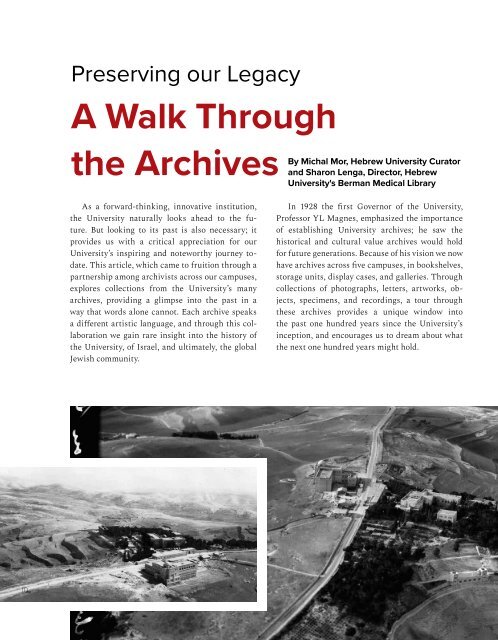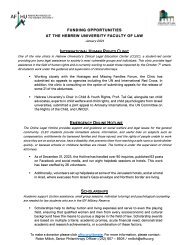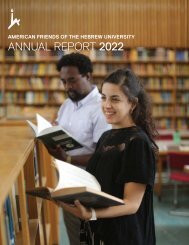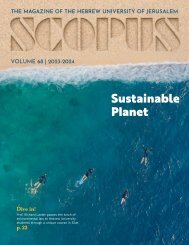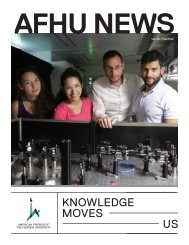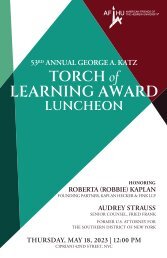Create successful ePaper yourself
Turn your PDF publications into a flip-book with our unique Google optimized e-Paper software.
Preserving our Legacy<br />
A Walk Through<br />
the Archives<br />
As a forward-thinking, innovative institution,<br />
the University naturally looks ahead to the future.<br />
But looking to its past is also necessary; it<br />
provides us with a critical appreciation for our<br />
University’s inspiring and noteworthy journey todate.<br />
This article, which came to fruition through a<br />
partnership among archivists across our campuses,<br />
explores collections from the University’s many<br />
archives, providing a glimpse into the past in a<br />
way that words alone cannot. Each archive speaks<br />
a different artistic language, and through this collaboration<br />
we gain rare insight into the history of<br />
the University, of Israel, and ultimately, the global<br />
Jewish community.<br />
By Michal Mor, Hebrew University Curator<br />
and Sharon Lenga, Director, Hebrew<br />
University's Berman Medical Library<br />
In 1928 the first Governor of the University,<br />
Professor YL Magnes, emphasized the importance<br />
of establishing University archives; he saw the<br />
historical and cultural value archives would hold<br />
for future generations. Because of his vision we now<br />
have archives across five campuses, in bookshelves,<br />
storage units, display cases, and galleries. Through<br />
collections of photographs, letters, artworks, objects,<br />
specimens, and recordings, a tour through<br />
these archives provides a unique window into<br />
the past one hundred years since the University’s<br />
inception, and encourages us to dream about what<br />
the next one hundred years might hold.<br />
The University Archive<br />
The University Archive includes invaluable records that<br />
preserve our institutional memory, allowing us to trace the<br />
processes that led to significant academic and administrative<br />
decisions since the University’s beginnings. The Archive began<br />
three years after the founding of the University and was housed<br />
on the Mount <strong>Scopus</strong> campus until the campus was isolated<br />
during the War of Independence in 1948. The archival material<br />
was eventually recovered and transported in armored vehicles<br />
to a number of buildings in Jerusalem. With the opening of the<br />
Givat Ram Campus in 1958, the archive was transferred, only<br />
to be returned to Mount <strong>Scopus</strong> in 1979. Approximately five<br />
percent of materials were lost during this period. Today the<br />
archival content extends over 420 meters with close to 33,500<br />
files. Numbered archival boxes are stored on shelves behind<br />
fire-proof metal doors.<br />
The Archive’s “Provisional Organizing Committee” document<br />
provides a fascinating look into the beginnings of the University.<br />
This document indicates the organizational roles and functions of<br />
all those involved in the celebrations marking the opening of the<br />
University, providing a first-hand account of the guidelines that the<br />
organizing committee in Jerusalem received from those overseas,<br />
including instructions on how to arrange the opening ceremony,<br />
seating preferences, flower arrangements, and guest lists.<br />
The Aerial Photography Archive<br />
10<br />
The Aerial Photography Archive<br />
contains photographs dating back<br />
to the years of 1917-18, some of<br />
which were taken by Prussian and<br />
Australian flight squadrons during<br />
World War I. The archive also contains<br />
photographs from the early period<br />
of the British Mandate, including a<br />
project during the years of 1944-48<br />
to systematically map Palestine. The<br />
Jewish Agency and even the Palmach<br />
used these photographs during the<br />
War of Independence.<br />
Aerial photographs provide a unique visual record of<br />
events, map surfaces of the past, and monitor changes in<br />
the landscape. These photographs document landscapes<br />
from specific times, incidental or planned; they constitute<br />
two- and three-dimensional analog cartographic models.<br />
Aerial photography has transitioned from analog to<br />
digital and in recent years has undergone revolutionary<br />
changes with the introduction of drone technology.<br />
Aerial photography is now able to capture very high<br />
spatial resolutions on the scale of a single centimeter<br />
using several spectral channels. This archive is managed<br />
by the Center for Computational Geography, and contain<br />
roughly 100,000 photographs that function as a source<br />
for research.<br />
11


